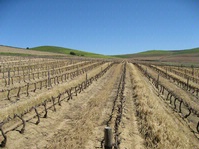CAPE TOWN, South Africa — Granted, Sancerre and Pouilly-Fumé from France’s Loire Valley, along with New Zealand’s Marlborough region, are the 800-pound gorillas of the Sauvignon Blanc world. However, from my current vantage point here in Africa (where they know a thing or two about gorillas), neither the French nor the Kiwi renditions of Sauvignon look quite so big and bad.
Many American wine lovers are still not up-to-speed on South  African wine as a result of relatively spotty distribution Stateside, but three days of intensive tasting here at Cape Wine 2008 (a huge, bi-annual national wine trade show) have demonstrated conclusively that this country can make kick-ass wine from an impressively wide range of grape varieties. I was also here for Cape Wine in 2006, so this is a confirmation experience rather than an epiphany for me. But the very high caliber of top South African wines remains newsworthy on account of their lamentable scarcity in the USA, and the diffusion of excellence across new regions and start-up producers has come as quite a revelation to me.
African wine as a result of relatively spotty distribution Stateside, but three days of intensive tasting here at Cape Wine 2008 (a huge, bi-annual national wine trade show) have demonstrated conclusively that this country can make kick-ass wine from an impressively wide range of grape varieties. I was also here for Cape Wine in 2006, so this is a confirmation experience rather than an epiphany for me. But the very high caliber of top South African wines remains newsworthy on account of their lamentable scarcity in the USA, and the diffusion of excellence across new regions and start-up producers has come as quite a revelation to me.
Sauvignon Blanc provides an excellent case in point. Truly top-flight Sauvignons are now made in an impressive number of distinct appellations, including Stellenbosch, Elim, Walker Bay, Elgin, Constantia, and Cape Point–among others. But to that list you’d better add Durbanville, a region that may be entirely new to you (as it was nearly new to me), that now has nine wineries that are making extremely convincing Sauvignon.
 The region is located up in the hills (verging on mountains) to the west and north of Cape Town, and on a clear day, the views of the city and the Cape are absolutely stunning. Altitude and proximity to the cooling waters of two oceans (Atlantic and Indian, in case your geography is rusty) make for cool temperatures, especially at night, which explains the bright, driving acidity that runs through the wines.
The region is located up in the hills (verging on mountains) to the west and north of Cape Town, and on a clear day, the views of the city and the Cape are absolutely stunning. Altitude and proximity to the cooling waters of two oceans (Atlantic and Indian, in case your geography is rusty) make for cool temperatures, especially at night, which explains the bright, driving acidity that runs through the wines.
However, these wines are not just about acidity. The rolling hills provide a variety of exposures to the sun, making it possible for winemakers to attain varying degrees of ripeness to fill out the body and flavor of their wines. Those who prefer a fuller, fleshier style can get it here, and some of the regions Sauvignons show hints of tropical fruit, whereas others who favor a leaner, brighter, citrus fruit site can get what they want as well. Some of the top wines actually show both of these fruit profiles at once, which can make for an especially interesting experience.
Although Chenin Blanc gets a lot of attention here as a contender for the role of South Africa’s calling-card white, it sure looks to me as though Sauvignon has a clear edge at this point. Keep an eye on this appellation and on its top Sauvignons more generally–the best of them should likewise have the French and the Kiwis looking over their shoulders….
1
